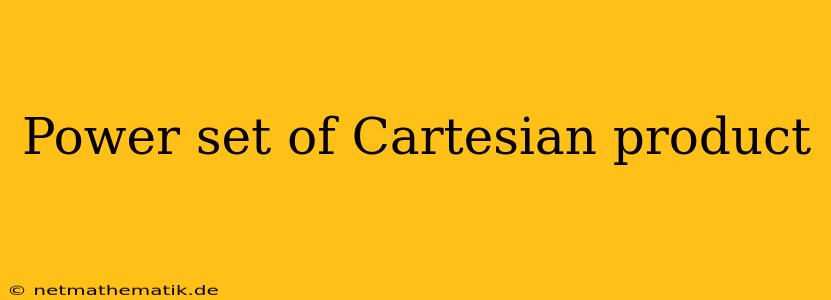The power set of a Cartesian product is a fundamental concept in set theory that combines the power sets of individual sets involved in the product. It involves understanding both Cartesian products and power sets, and how they interact to create a new, larger set of all possible subsets. This article explores the power set of a Cartesian product, its properties, and how it relates to other mathematical concepts.
Understanding the Basics: Cartesian Product and Power Set
Before diving into the power set of a Cartesian product, it's crucial to define the core concepts:
Cartesian Product
The Cartesian product of two sets, denoted by $A \times B$, is the set of all possible ordered pairs where the first element comes from set A and the second element comes from set B.
For example, if $A = {a, b}$ and $B = {1, 2}$, then their Cartesian product is:
$A \times B = {(a, 1), (a, 2), (b, 1), (b, 2)}$.
Power Set
The power set of a set, denoted by $P(A)$, is the set of all possible subsets of that set, including the empty set and the set itself.
For example, if $A = {a, b}$, then its power set is:
$P(A) = {\emptyset, {a}, {b}, {a, b}}$.
Power Set of the Cartesian Product: Combining Concepts
Now, let's consider the power set of the Cartesian product of two sets, $A$ and $B$. This set is denoted as $P(A \times B)$, and it contains all the possible subsets of the Cartesian product $A \times B$.
Important Note: The power set of the Cartesian product is not the same as the Cartesian product of the power sets. In other words, $P(A \times B) \neq P(A) \times P(B)$.
Example
Let's illustrate this with an example. Consider $A = {a, b}$ and $B = {1, 2}$ as before. We already know:
$A \times B = {(a, 1), (a, 2), (b, 1), (b, 2)}$.
Therefore, the power set of the Cartesian product, $P(A \times B)$, will be:
$P(A \times B) = {\emptyset, {(a, 1)}, {(a, 2)}, {(b, 1)}, {(b, 2)}, {(a, 1), (a, 2)}, {(a, 1), (b, 1)}, {(a, 1), (b, 2)}, {(a, 2), (b, 1)}, {(a, 2), (b, 2)}, {(b, 1), (b, 2)}, {(a, 1), (a, 2), (b, 1)}, {(a, 1), (a, 2), (b, 2)}, {(a, 1), (b, 1), (b, 2)}, {(a, 2), (b, 1), (b, 2)}, {(a, 1), (a, 2), (b, 1), (b, 2)}}$.
Properties of the Power Set of the Cartesian Product
The power set of the Cartesian product exhibits several interesting properties:
-
Cardinality: The cardinality of $P(A \times B)$ is $2^{|A \times B|}$, where $|A \times B|$ is the cardinality of the Cartesian product. This is because each element in the Cartesian product can either be included or excluded in a subset, leading to $2$ possibilities for each element.
-
Subset Relation: Every element in $P(A \times B)$ is a subset of $A \times B$. This follows directly from the definition of a power set.
-
Relationship to Power Sets of Individual Sets: While $P(A \times B)$ is not the same as $P(A) \times P(B)$, there is a relationship. Any subset of $A \times B$ can be formed by taking a subset of $A$ and a subset of $B$ and forming all possible ordered pairs between elements of those subsets. However, it's important to remember that $P(A) \times P(B)$ will contain subsets that cannot be formed in this way, leading to the inequality between the two sets.
Applications of the Power Set of the Cartesian Product
The power set of the Cartesian product finds applications in various areas, including:
-
Combinatorics: The power set of a Cartesian product is used to count the number of possible combinations of elements from two or more sets. For example, in a situation where you have $n$ different types of items, and you need to select $k$ items, the power set of the Cartesian product of sets representing the different types of items can be used to enumerate all possible combinations.
-
Computer Science: The concept of a power set is crucial in algorithms that involve searching for all possible combinations, such as in graph traversal or optimization problems. The power set of a Cartesian product can be used to represent all possible states of a system, allowing algorithms to explore all possible solutions.
-
Statistics: In statistical analysis, the power set of a Cartesian product is used to define the sample space for random experiments. Each element in the power set represents a possible outcome of the experiment, and the probability of each outcome can be calculated based on the underlying distribution.
Conclusion
The power set of the Cartesian product is a powerful concept that combines the ideas of Cartesian products and power sets. It enables us to represent all possible subsets of the Cartesian product, providing a valuable tool for analyzing and understanding relationships between sets. This concept has diverse applications in various fields, highlighting its importance in both theoretical and practical contexts. Understanding the properties and implications of the power set of the Cartesian product can deepen our understanding of set theory and its applications in diverse fields of study.
